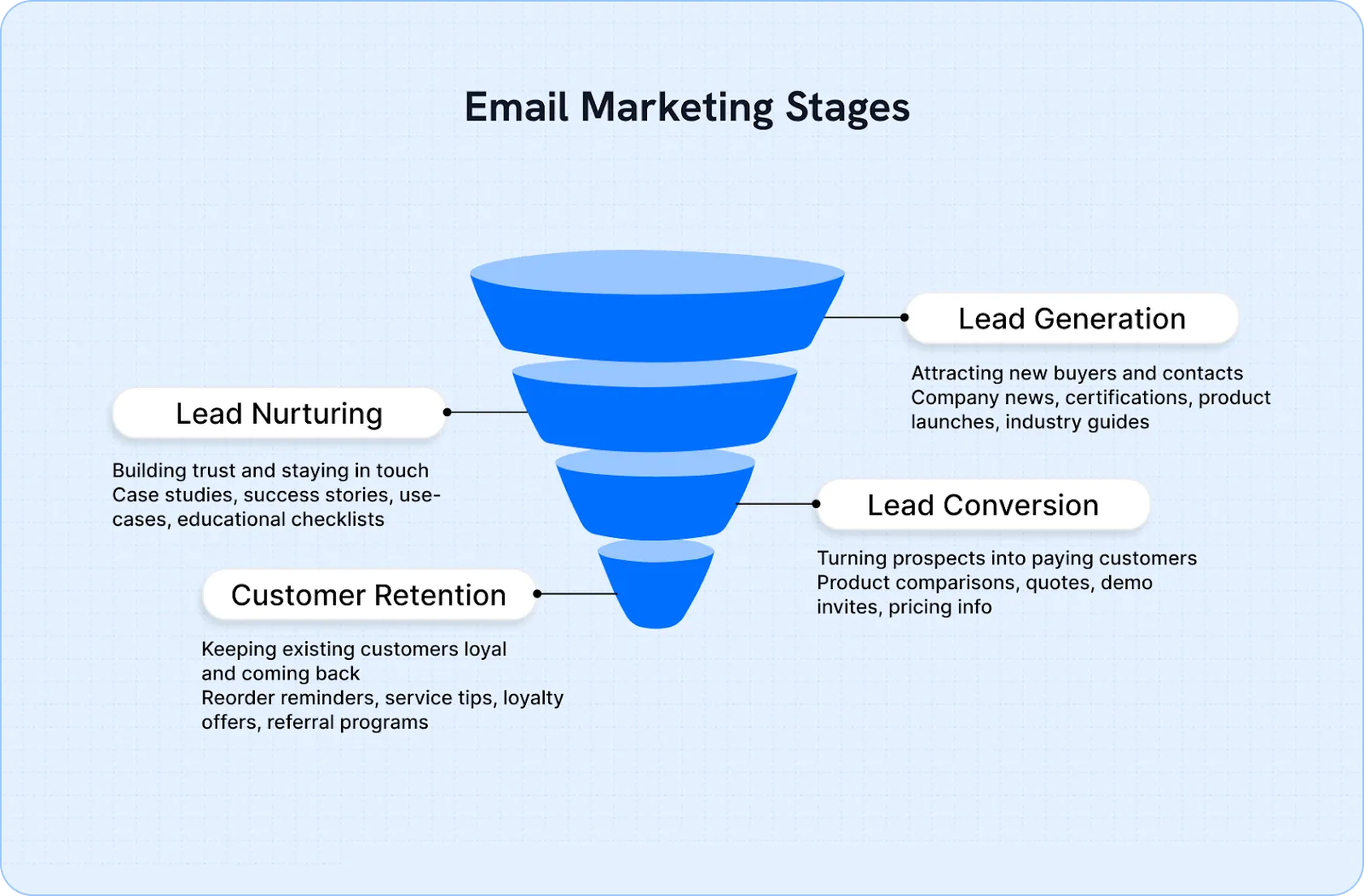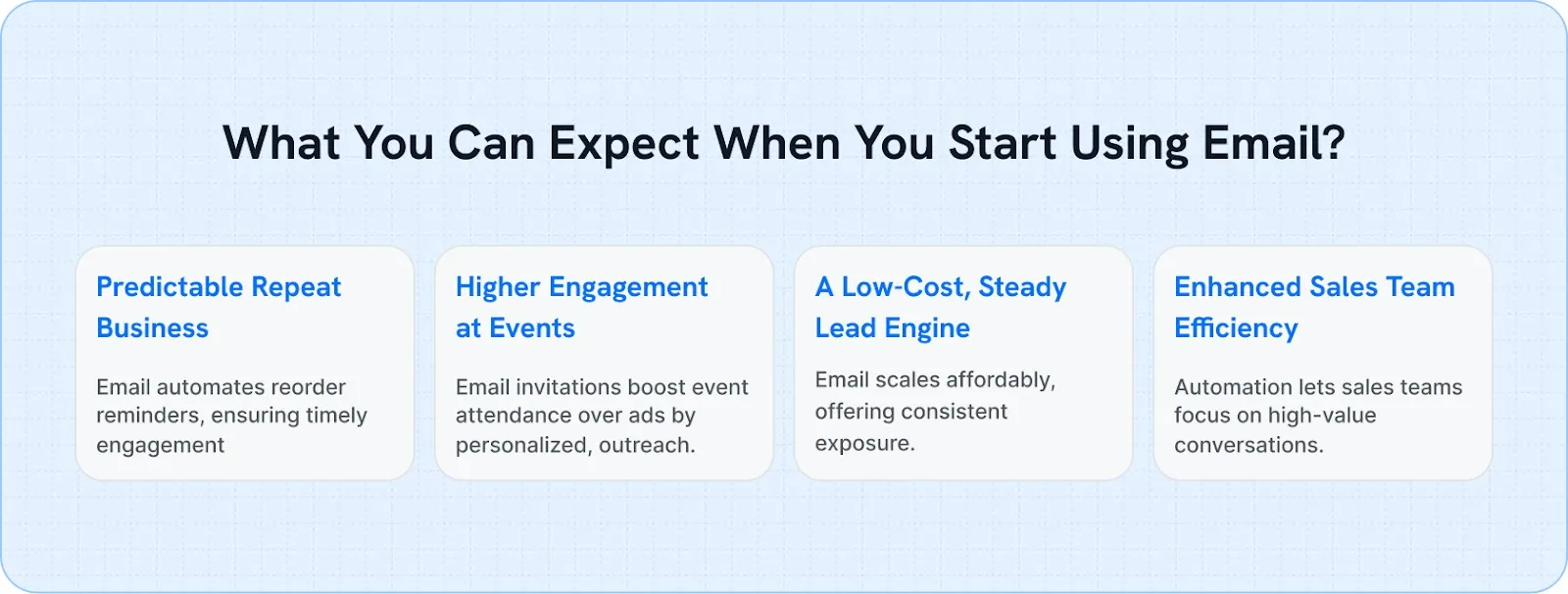Manufacturing sales move in cycles. One month you’re busy with trade shows and inquiries, the next you’re waiting on calls to be returned or ads to deliver leads. That stop-and-go rhythm makes it difficult to stay visible to buyers consistently.
Email changes that. It works quietly in the background, steady, low-cost, and always on, so your company remains present even when other channels pause.

TL;DR:
- Email provides year-round visibility. Unlike trade shows, calls, or ads that spike and fade, email keeps your company present during long decision cycles.
- Manufacturing buyers already rely on email. From procurement schedules to technical updates, it’s where they expect to receive timely information from suppliers.
- Performance is proven. Average open rates reach 42.35% across industries and 34.48% in manufacturing, showing that B2B email consistently gets read.
- ROI outpaces other channels. Email delivers about $36 for every $1 spent with an 85.7% delivery rate, making it both cost-effective and dependable.
- Consistency builds trust. Regular, useful touchpoints compound over time, positioning your company as the supplier buyers remember when decisions are made.
What Does Email Marketing Actually Mean for Manufacturers?
Email marketing is just a way to stay in touch with the people who matter to your business: buyers, distributors, and prospects. Instead of waiting for the next trade show or hoping a phone call gets through, you can send simple, useful updates straight to their inbox. That might be news about a new product, a reminder when it’s time to reorder, or a short tip that helps them use your equipment better.
Because these emails go to people who already know your company or have shown interest, they’re not random or spam. They’re part of the same sales process you already follow, only supported by email.
And just like your sales process, email marketing also moves through a few clear stages:

Think about it like a steady nudge; email helps buyers remember you without needing constant follow-ups from sales.
The Biggest Myths About Email as a Marketing Channel
Many manufacturers hesitate with email marketing because of a few common misconceptions. Let’s break them down.
Myth 1: Email is only for consumer brands
Not true. Distributors, procurement teams, and plant managers all rely on email every day. If anything, B2B buyers expect to see updates in their inbox, stock availability, delivery schedules, or product specifications are all things they’d rather get by email than chase by phone.
Myth 2: It takes too much time to manage
Modern tools make it manageable. Once set up, routine emails like reorder reminders, thank-you notes, or product updates can run automatically, saving your sales team hours of repeated follow-up.
Myth 3: Customers don’t read emails
The numbers tell a different story. Email delivers an average ROI of $36 for every $1 spent, making it the highest-performing marketing channel by return. And with an average delivery rate of 85.7%, most of those messages reliably reach the inbox, proof that buyers are opening and acting on them.

Myth 4: You need fancy designs or a marketing team
In reality, most effective B2B emails are plain and straightforward. Buyers care about clear information, not graphics. A short update with the right subject line is often more powerful than a polished template.
Myth 5: Buyers only want calls
Calls still matter, but they’re hard to scale. Research shows that only about 2% of cold calls result in a meeting. Email gives you a more reliable way to reach buyers; they can open it on their own time and refer back when they’re ready.
Myth 6: It’s too complicated to start
For many manufacturers, email feels like one more task in an already stretched day. But when it’s built around real needs, specifications, compliance updates, and reorder cycles, it stops feeling like ‘marketing’ and becomes a natural extension of sales.
With the right setup, it becomes one of the easiest ways to keep buyers engaged. The difference comes from designing around how the industry actually works: long cycles, distributor networks, and technical requirements.
Most of these myths fade once you look at how buyers actually behave. Email is already part of their day, which makes it a practical tool for manufacturers to use.
Why Email Fits Right Into Manufacturing Sales
Most manufacturers rely on a familiar mix of channels: trade shows, cold calls, and paid ads. Each has its place, but each also comes with limits:
- Trade shows bring visibility and connections, but they’re seasonal; you can’t rely on them year-round.
- Cold calls can work, but they depend on sales reps’ time. Research shows it takes an average of 209 calls to secure a single appointment or referral, a hard number to scale.
- Paid ads bring quick leads, but the moment you pause the budget, the leads disappear.
Put together, these channels create short bursts of activity, not the steady growth manufacturers need.
Email works differently.

- Reaches buyers directly — your message lands in their inbox, ready when they are.
- Costs less than most other lead-generation methods.
- Keeps your company remembered during long decision cycles.
For manufacturers, that consistency is critical. Sales cycles are long, buyers evaluate multiple suppliers, and decisions can take months. Without steady touchpoints, it’s easy to be forgotten. Email fills that gap, working quietly in the background so that when buyers are ready to move forward, your name is still top of mind.
Everyday Industrial Sales Challenges—and How Email Helps

Industrial sales cycles are long and complex, and common challenges continue to slow progress. Email may not replace other channels, but it provides a structured way to reduce these pressures.
1. Pipeline gaps
Interest from inquiries or events is often uneven, leaving stretches with little buyer interaction. Email maintains continuity by providing timely updates, such as certifications, specification changes, or industry insights, that keep your company present between direct touchpoints.
2. Sales teams are stretched thin
Most manufacturing sales teams are small, balancing prospecting, distributor management, and technical support. Automated emails handle routine communication, order reminders, thank-you notes, or meeting follow-ups, so staff can focus on the discussions that move opportunities forward.
3. Leads going cold
Promising contacts frequently stall when buyers are occupied with other priorities. Regular, useful touchpoints, maintenance tips, product updates, or case studies keep your business visible and relevant until buyers are ready to continue the conversation.
4. Rising marketing costs
Traditional channels such as events or advertising remain important but require significant and recurring budgets. Email, by contrast, scales efficiently: reaching one hundred or ten thousand buyers carries nearly the same cost, making it a practical way to sustain visibility.
These challenges are well known in manufacturing. Email helps by providing consistency: a channel that stays active in the background, ensuring that when buyers are ready to decide, your company has remained part of the conversation.
Read: Digital Marketing Guide for B2B Manufacturers & Industrial Companies
Three Core Strategies for Effective Email Campaigns
Email marketing for manufacturers isn’t about mass promotions or decorative mailers. What makes it effective is an approach that mirrors how buyers actually make decisions: carefully, with attention to detail, and over time.
That means structuring emails to match the way they research, evaluate, and purchase, rather than relying on generic marketing patterns.
1. Segment buyers by how they interact with your business

No distributor, direct customer, or prospect should receive the same message. Their expectations are different, and so are the decisions they make:
- Distributors look for stock availability, pricing updates, and marketing resources they can pass downstream.
- Direct customers need reorder reminders, service notices, and clear technical documentation.
- Prospects—especially engineers and procurement teams—respond better to educational material like case studies, certifications, or side-by-side comparisons.
Segmentation ensures you’re not speaking into the void. It shows buyers you understand their role, and that makes them far more likely to read and act on what you send.
2. Keep emails concise, but purposeful
Inboxes in manufacturing are full of quotes, specifications, and supplier updates. Lengthy marketing emails get ignored. Clarity wins:
- A subject line that signals value immediately (“Spec update: [Product Name]”).
- Two or three short sentences that explain what’s changed, why it matters, and what to do next.
- Attachments or links only when they save time—like a PDF spec sheet, an updated drawing, or a maintenance checklist.
Often, a plain-text note written like a business email outperforms a designed template. Buyers aren’t judging your design; they’re scanning for the information that helps them do their job.
3. Automate what’s routine, but don’t lose the human element

Sales teams in manufacturing already stretch across technical calls, distributor coordination, and long negotiations. Adding manual follow-ups for every inquiry is unsustainable. Automation helps by handling what repeats: reorder reminders, thank-you emails after a meeting, or follow-ups post-trade show. But automation doesn’t mean impersonal.
Use simple cues, like referencing a previous order or addressing the buyer’s specific role, to keep it relevant. For strategic opportunities, layer in personal outreach on top of automated workflows. Done well, this combination keeps leads warm, ensures no touchpoint is missed, and still leaves space for sales teams to focus on high-value conversations.
Giving Buyers a Reason to Share Their Email
Buyers rarely share their email address without a clear reason. Their inbox is already crowded with quotes, supplier updates, and compliance notices. To earn a spot there, your offer needs to be useful enough to cut through the noise.
The strongest incentives are practical resources that support their work:
- Maintenance checklists that help engineers prevent downtime.
- Invitations to demos, webinars, or plant visits that let prospects see your expertise in action.
- Technical guides or comparison charts that make procurement decisions faster and easier.
These resources are not promotional; they are tools buyers actively need to perform their roles. When positioned as part of your email program, they do more than collect addresses; they build a list of engaged contacts who enter with intent and are more likely to convert into qualified opportunities.
What You Can Expect When You Start Using Email

When you begin using email consistently and thoughtfully, the impact becomes clear, and it emerges sooner than you'd expect.
1. Predictable Repeat Business
Automating reorder reminders and service updates lands your brand in the inbox at the exact moment buyers are most open to purchasing again. You're not chasing orders; you're showing up when they’re already interested.
2. Higher Engagement at Events
Invitations sent by email outperform generic leads generated from ads or word-of-mouth. Structured, informative email outreach encourages real-world attendance, whether at trade shows, webinars, or plant tours.
3. A Low-Cost, Steady Lead Engine
The financial efficiency of email is hard to beat: reaching 1,000 buyers costs nearly the same as sending to ten. Compared to trade shows or digital ads, email scales affordably while delivering consistent exposure.
4. Enhanced Sales Team Efficiency
With automated nurture sequences and timely updates, sales teams spend less effort chasing lukewarm leads and more time in conversations that matter. It’s not about replacing the sales process; it’s about strengthening it behind the scenes.
Email delivers early wins, but its real value is consistency. Over time, it builds a steady rhythm of engagement that supports every stage of the sales cycle.
Easy Tools Manufacturers Can Use Right Away
Getting started with email doesn’t require a heavy investment. Beginner-friendly platforms like Mailchimp, HubSpot, or ActiveCampaign can manage the basics, organizing contacts, sending routine updates, and tracking open or click rates.
The specific tool matters less than how you use it. A clean contact list, consistent follow-ups, and emails that address real buyer needs will do more for sales than any advanced feature. Think of these platforms as support in the background; the real impact comes from the relevance of the content you deliver.
Getting Your First Email Campaign Off the Ground
The most difficult part of email marketing is often the first step. Once a simple foundation is in place, momentum builds quickly. A practical starting campaign might look like this:
- Build a clean contact list. Export addresses from your CRM, inquiry forms, and past customer records into one place. A reliable list matters more than size.
- Add a sign-up option to your website. Even a basic form gives interested buyers a direct path to hear from you.
- Offer something useful in return. A product guide, updated spec sheet, or maintenance checklist makes the exchange worthwhile for the buyer.
- Reconnect with past customers. A short “re-introduction” email with an update or product highlight is often enough to restart conversations.
- Check how it looks on mobile. Most buyers will read your message on their phone; clarity there is non-negotiable.
- Set a steady rhythm. Even one email per month is a start; the key is consistency, not volume.
- Review the results. Opens, clicks, and replies are signals that show what caught attention and where to adjust next time.
The first campaign doesn’t have to be perfect. What matters is building a process you can repeat and refine. That’s the real strength of email marketing for manufacturers: consistency compounds into long-term results.
Tracking What Works

Email only creates value if you can see whether it’s working. For manufacturers, that doesn’t mean monitoring dozens of dashboards; it means focusing on the handful of signals that tie directly to sales outcomes.
- Open rate indicates if your subject lines are strong enough to break through a crowded inbox.
- Clicks highlight which content buyers find most relevant—whether it’s a spec sheet, a case study, or a reorder link.
- Replies show when an email has moved beyond marketing and started a real conversation.
- Orders—or formal Requests for Quotation (RFQs)—confirm the direct link between your email campaigns and revenue.
The point of tracking isn’t to collect numbers; it’s to identify what moves buyers closer to a decision, and refine your emails around that.
Ready to Make Your First Campaign Count?
Launching an email program is easier when you have a clear process, but building one that consistently delivers qualified leads takes experience. That’s where we guide manufacturers every day.
At Gushwork, we’ve worked with equipment makers, component suppliers, distributors, and contract manufacturers to design email systems that:
- Nurture inquiries from trade shows and convert them into active opportunities.
- Keep distributors engaged with tailored updates they actually use.
- Support sales teams with automated follow-ups that free them to focus on high-value deals.
For many of our clients, the first campaign was just the starting point. What made the difference was setting up email as a dependable channel that worked quietly in the background, month after month.
If you’re planning your first campaign or ready to strengthen what you’ve started, we can help you design it the right way. Start with a free lead audit to see exactly where opportunities are being missed, and how a structured email system can capture them.

Email Challenges Manufacturers Face
Even well-planned email programs encounter challenges. The difference between wasted effort and measurable results often comes down to how you address them:
1. Emails that read like sales pitches
Overly promotional messages are quickly dismissed. Instead, focus on updates that demonstrate value, such as new certifications, practical maintenance tips, or customer case studies that highlight real outcomes.
2. Low engagement from distributors
Distributors manage multiple supplier relationships, and generic emails are easy to ignore. Tailored updates on pricing, stock availability, or co-marketing resources make your message relevant to their priorities.
3. Technical buyers not opening emails
Engineers and procurement teams are unlikely to open emails with vague subject lines. Specific, need-based subjects, like ‘Reduce downtime with [Product]’ or ‘Updated spec sheet for [Component]’—make it clear why the email matters and are far more likely to get attention.
4. Inconsistent follow-up after trade shows or inquiries
Leads collected at events often go cold without timely outreach. A simple automated sequence, thank-you, resource share, and next steps, keeps your company present while interest is still high.
5. Data scattered across teams
When sales, marketing, and operations keep separate contact lists, accuracy suffers. Centralizing data into a single database and refreshing it every three to six months ensures emails reach the right audience.
These problems are not unique, and they are not insurmountable. With structured fixes, email shifts from a channel of missed opportunities to one of steady, reliable growth.
Bringing It All Together: Where Email Fits in Manufacturing Sales
Email creates a rhythm that other channels rarely sustain. Routine updates, spec changes, service tips, reorder reminders, keep your company present without overwhelming sales teams. Over time, those steady touchpoints build familiarity and trust, which often proves decisive when buyers finalize their shortlist.
Want to Learn More?
If this guide gave you ideas, explore our other resources on manufacturing lead generation, distributor engagement, and industrial marketing strategies. The more you understand how buyers behave, the easier it becomes to build consistent growth.
Frequently Asked Questions
1. What are the 4 P’s of email marketing?
The 4 P’s are: Personalization (make emails relevant), Precision (keep the message clear and concise), Persistence (send consistently to stay visible), and Performance (track results like opens, clicks, and replies to refine future campaigns).
2. How often should manufacturers send marketing emails?
Most manufacturers see results starting with one email per month. The key is consistency; emails should provide updates that buyers value, such as certifications, product launches, or event invites. Frequency can increase over time, but quality and relevance should always come before volume.
3. Do technical buyers really read marketing emails?
Yes—when the content is relevant. Engineers and procurement teams often skip broad promotions but open emails with specific value, like spec sheet updates, maintenance checklists, or technical comparisons. Precision in subject lines and content makes a big difference in engagement.
4. What kind of results can manufacturers expect from email marketing?
Email usually delivers quick wins like repeat orders and higher event turnout. Over time, it creates consistent visibility in long buying cycles, making your company more likely to stay on the shortlist. It’s not just about leads, it’s about being remembered when decisions are made.
5. How to do marketing for a manufacturing business?
Successful manufacturing marketing blends traditional channels (trade shows, referrals, distributor networks) with digital channels like email, SEO, and educational content. The goal isn’t short bursts of visibility but steady engagement that builds credibility and keeps your company top of mind all year.


















.webp)








.webp)

.svg)


.svg)
.svg)
.svg)







.svg)